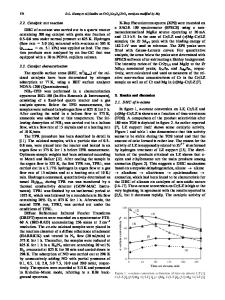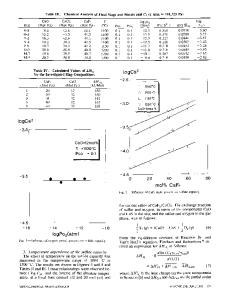Experimental Studies on the Sulfide Capacities of CaO-SiO 2 -CrO x Slags
- PDF / 555,876 Bytes
- 7 Pages / 593.972 x 792 pts Page_size
- 28 Downloads / 354 Views
URIZATION during stainless-steel production generally is carried out during a reduction period in an argon oxygen decarburization converter after decarburization. Prior to this reduction period, an Ar-O2 mixture is blown into the melt for decarburization, and a significant amount of chromium from the steel bath would enter the slag phase because of the inevitable oxidation caused by its high-oxygen affinity. It would be interesting to understand the impact of the chromium-oxide presence in the slag on the desulfurization process. Although earlier efforts have been focused on the measurements of the sulfide capacities of multicomponent slags between 1673 K and 1923 K,[1–12] a survey of literature revealed only one earlier work on the sulfide capacities of chromiumoxide-containing slag.[13] The experimental difficulties associated with these measurements because of the high liquidus temperatures of slags containing chromium oxide as well as the existence of chromium in two different valence states, viz. Cr2+ and Cr3+ under LIJUN WANG, Ph.D. Student, formerly with the Department of Materials Science and Engineering, Royal Institute of Technology, Stockholm, Sweden, is now with Department of Physical Chemistry, University of Science and Technology Beijing, 30 Xueyuan Road, Haidian District, Beijing 100083, P. R. China. Contact e-mail: [email protected] SESHADRI SEETHARAMAN, Professor, is with the Department of Materials Science and Engineering, Royal Institute of Technology, Brinellvagen 23, SE-10044, Stockholm, Sweden. Manuscript submitted September 4, 2009. Article published online January 5, 2010. METALLURGICAL AND MATERIALS TRANSACTIONS B
different experimental conditions, present serious challenges to these measurements. For the chromium-containing slag, measurements of the thermodynamic activities of chromium oxides have been carried out earlier by Pretorius and Muan,[14] Xiao and Holappa,[15] as well as Morita and Sano.[16] The latter authors also have examined the solubility of chromium spinel MgO-Cr2O3 in CaO-MgO-Al2O3-SiO2 melts.[17] Phase diagram studies of chromium-oxidecontaining slags under various conditions also have been found in literature.[18–21] Several studies have been carried out earlier in regard to the distribution of chromium between Cr2+ and Cr3+ by several researchers.[15,16,22–25] A critical survey of the earlier publications revealed that some of the results show a wide scatter. Furthermore, in some cases, the Cr2+/Cr3+ ratio reported showed an increase with an increasing basicity, which may be contrary to the trend shown for Fe2+/ Fe3+ in FeO-containing slags.[26] Efforts were made by Forsbacka and Holoppa[27,28] to understand the behavior of chromium-oxide-containing slags using viscosity measurements as a possible route. These authors determined the viscosities of CaO-SiO2-CrOx slags at 1873 K under two extreme oxygen potentials. This investigation is focused on the sulfur-removing capacity of melts in the CaO-SiO2-CrOx system, which is part of an extensive study of chromium-oxide-containing slags to o
Data Loading...











